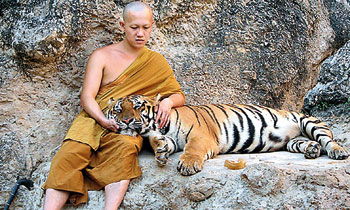Since the millennium Sri Lankans have been bitten by the travel bug- outbound traffic from Sri Lanka has almost doubled. Recent statistics show that 43 % Sri Lanka’s outbound traffic is to Bangkok and other destinations in South East Asia.
With Lankan travellers now looking beyond Bangkok for their family vacation, Thai tourism authorities have introduced two new destinations in Thailand close to the capital Bangkok.
The Kanchanaburi- mountain experience and Hua Hin Beach are now being offered to Sri Lankans by Cathay Pacific, which takes the highest number of Lankan passengers to Bangkok, flying every Monday, Wednesday and Friday.
Kanchanabur is just three hours drive from Bangkok. The leading attraction of this mountain region is the Death Railway and the Tiger Temple.
The tiger (Panthera Tigris) is a beloved, yet most feared species of animal in the world. But for the monks in the Wat Pa Luangta Bua popularly known as Tiger Temple, they are just big cats.
Here the huge Bengal tigers breed, feed and even roam with human beings. Since its opening in 1994, Wat Pa Luangta Bua has gained a reputation as a wildlife sanctuary. It started with an injured jungle fowl being given to the monks by the villagers. Attracted by the calls of the by then rather large colony of jungle fowl, Peacocks too flocked to the area. An injured wild boar stumbled into the monastery and the monks cared for it until it could be released back into the forest.
These were the beginnings of this animal sanctuary .The monastery is in the Kanchanaburi province, adjacent to Burma. The Western Forest complex that stretches along the border is the largest protected area in Asia and is believed to be home to the largest surviving tiger population in the region. Unfortunately, though this is a protected area, poaching still occurs frequently. ‘A Thai poacher can be fined upto US $5,800 for killing a tiger-- several years’ salary for a farmer.
It was an injured tiger that paved the way for this world's first tiger temple, way back in 1994. The tiger had made it to the nearby temple where the priests nursed its injuries and provided food for the animal to limp back to health. When the tiger recovered, the monks tried to release it to the wilds but it did not want to leave and it became a permanent resident there. One month later, another tiger joined it and formed a family.
Just a few weeks after, two healthy male cubs rescued from poachers were brought to the monastery. They were just a few weeks old. A few months later the villagers presented the temple with another two male cubs. And soon after the border police patrol intercepting another gang of poachers handed over four female cubs.
According to the head monk of the monastery, they welcomed the animals and as he had no previous experience in looking after large carnivores he had to learn on the job. At first he built some concrete pans – all he could afford, to isolate the cubs and prevent them from killing the temple’s other animals.
As the years went by the tigers grew up and to the monk’s delight started breeding.
However, as the tiger family grew the monk was faced with the need to create more living space for his charges. As early as in 2003 an ambitious plan to create a large open air enclosure where each tiger would be given enough land was conceived and construction began.
The government, meanwhile, brought in an Act banning the rearing of tigers in private homes and people who used to own tigers released them to the Tiger temple. As of 2007, over 21 cubs have been born at the temple.
“Now we have 90 adult tigers and 12 cubs. Since these tigers have lived with humans they cannot survive in the jungle and they preferred to stay with us,” the monk added.
Being a forest monastery, no alcohol is allowed at the site. Additionally "appropriate" clothing must be worn by women, covering their shoulders and knees, so as not to offend the monks within the site.
The monk said the big cats are fed normal rice and curry with chicken only. No heavy meat is given to them. “We bring the tigers to the visitors during afternoon hours. They are allowed to touch them only with the trainer in attendance,” he said.
Due to its popularity, Thailand Tourism, together with Cathay Pacific, is now opening the world's first tiger park manned by Buddhist monks to Sri Lankan travellers.
The airline, which operates three flights a week has organized a special package (Tiger Temple and Death Railway- Real Bridge on River Kwai) which also provides a night in Felix River Kwai Resort, the only five-star resort in Kanchanaburi.
Next week: The Death Railway.
The writer was part of a
media tour group sponsored by Cathay Pacific Airways
Special package
Cathay Pacific Airways has introduced a special Bangkok Super Package for Sri Lankan travellers.
Enjoy two nights and three days in this thriving destination with Cathay Pacific's Bangkok Super Package, which comprises a return economy class air ticket, two nights hotel accommodation with breakfast and return airport transfer from hotel to airport by coach. A selection of hotels ranging from 3 to 5 star (standard to deluxe room types) are available and can be extended for an extra charge per night / person.
The package with accommodation at a three-star hotel/ standard room/ on twin sharing basis is Rs 28,500 excluding taxes.
The tour cost to Kanchanabury and Hua Hin is added to this amount. |


